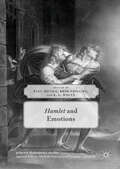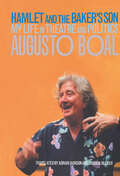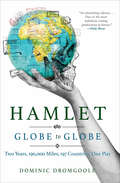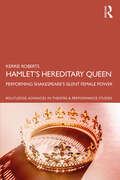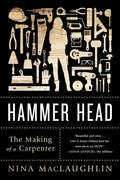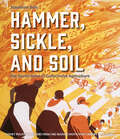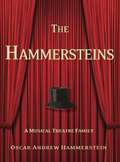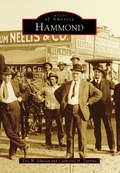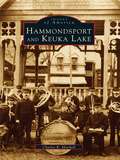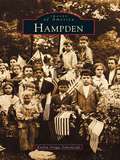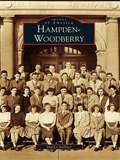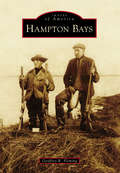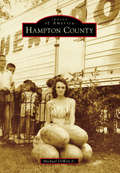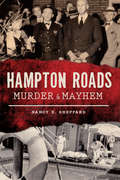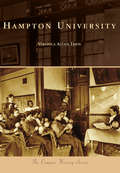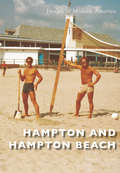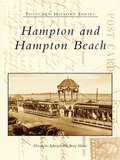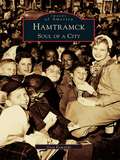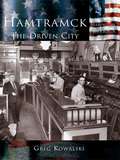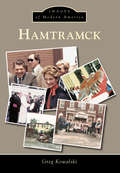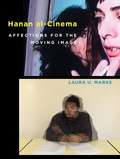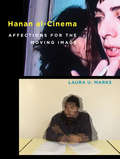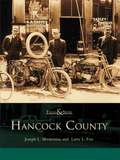- Table View
- List View
Hamlet and Emotions (Palgrave Shakespeare Studies)
by R. S. White Paul Megna Bríd PhillipsThis volume bears potent testimony, not only to the dense complexity of Hamlet’s emotional dynamics, but also to the enduring fascination that audiences, adaptors, and academics have with what may well be Shakespeare’s moodiest play. Its chapters explore emotion in Hamlet, as well as the myriad emotions surrounding Hamlet’s debts to the medieval past, its relationship to the cultural milieu in which it was produced, its celebrated performance history, and its profound impact beyond the early modern era. Its component chapters are not unified by a single methodological approach. Some deal with a single emotion in Hamlet, while others analyse the emotional trajectory of a single character, and still others focus on a given emotional expression (e.g., sighing or crying). Some bring modern methodologies for studying emotion to bear on Hamlet, others explore how Hamlet anticipates modern discourses on emotion, and still others ask how Hamlet itself can complicate and contribute to our current understanding of emotion.
Hamlet and the Baker's Son: My Life in Theatre and Politics (Augusto Boal)
by Augusto BoalHamlet and the Baker's Son is the autobiography of Augusto Boal, inventor of the internationally renowned Forum Theatre system, and 'Theatre of the Oppressed' and author of Games for Actors and Non-Actors and Legislative Theatre. Continuing to travel the world giving workshops and inspiration to teachers, prisoners, actors and care-workers, Augusto Boal is a visionary as well as a product of his times - the Brazil of military dictatorship and artistic and social repression and was once imprisoned for his subversive activities. From his early days in Brazil's political theatre movement to his recent experiments with theatre as a democratic political process, Boal's story is a moving and memorable one. He has devised a unique way of using the stage to empower the disempowered, and taken his methods everywhere from the favelas of Rio to the rehearsal studios of the Royal Shakespeare Company.
Hamlet: Globe to Globe: Two Years, 190,000 Miles, 197 Countries, One Play
by Michael Gallagher Dominic DromgooleFrom the artistic director of Shakespeare’s Globe Theatre in London, an account of the theater’s extraordinary two-year tour bringing Hamlet to every country on earth
Hamlet’s Hereditary Queen: Performing Shakespeare's Silent Female Power (Routledge Advances in Theatre & Performance Studies)
by Kerrie RobertsThis book explores a fresh and insightful interpretation of Hamlet’s Gertrude as a prominent and powerful figure in the play. It shows how traditional readings of this character, both performance-based and scholarly, have been guided and constrained by misogynistic perspectives on female power. Bringing together the author’s wealth of insight from a theatre practitioner’s perspective and combining it with a scholarly perspective, the book argues that Gertrude need not be limited to sex and motherhood. She could instead be played as Denmark’s blood royal Queen, her role in the play then being about female political power. Gertrude’s royal status could play out on stage through a variety of possible performance choices for stage design, stage business, acting processes, and the actor’s presence – both speaking and silent. Hamlet's Hereditary Queen takes into consideration Shakespeare’s source myths, historical studies of the position of queens and the issues concerning them in early modern England, Hamlet’s performance history, and the text itself. It questions traditional readings of Hamlet, and offers detailed analyses of relevant scenes to demonstrate how Gertrude’s Hamlet might play out on stage in the twenty-first century. This is an engaging and insightful interpretation for students and scholars of theatre and performance studies and Shakespeare studies, as well as theatre practitioners.
Hamlyn All Colour Cookery: Hamlyn All Colour Cookbook (Hamlyn All Colour Cookery)
by Oi CheepchaiissaraThai food is globally renowned for its distinctive flavours and delicious mix of spicy and sour tastes. No matter what your level of ability, experiencing this wonderful cuisine need not be limited to restaurant visits - Hamlyn All Colour Cookbook: 200 Thai Favourites will allow you to re-create that authentic Thai flavour in your own home. From firm favourites such as red curry with roasted duck to the more exotic such as red snapper with three-flavour sauce, this book has a dish to suit everybody. Each recipe is accompanied by easy-to-follow instructions and a full page colour photograph to ensure perfect results.
Hammer Head: The Making of a Carpenter
by Nina MaclaughlinA warm and inspiring book for anyone who has ever dreamed of changing tracks: the story of a young woman who quit her desk job to become a carpenter. Nina MacLaughlin spent her twenties working at a Boston newspaper, sitting behind a desk and staring at a screen. Yearning for more tangible work, she applied for a job she saw on Craigslist--Carpenter's Assistant: Women strongly encouraged to apply--despite being a Classics major who couldn't tell a Phillips from a flathead screwdriver. She got the job, and in Hammer Head she tells the rich and entertaining story of becoming a carpenter. Writing with infectious curiosity, MacLaughlin describes the joys and frustrations of making things by hand, reveals the challenges of working as a woman in an occupation that is 99 percent male, and explains how manual labor changed the way she sees the world. We meet her unflappable mentor, Mary, a petite but tough carpenter-sage ("Be smarter than the tools!"), as well as wild demo dudes, foul-mouthed plumbers, grizzled hardware store clerks, and the colorful clients whose homes she and Mary work in. Whisking her readers from job to job--building a wall, remodeling a kitchen, gut-renovating a house--MacLaughlin examines the history of the tools she uses and the virtues and varieties of wood. Throughout, she draws on the wisdom of Ovid, Annie Dillard, Studs Terkel, and Mary Oliver to illuminate her experience of work. And, in a deeply moving climax, MacLaughlin strikes out on her own for the first time to build bookshelves for her own father. Hammer Head is a passionate book full of sweat, swearing, bashed thumbs, and a deep sense of finding real meaning in work and life.
Hammer, Sickle, and Soil: The Soviet Drive to Collectivize Agriculture
by Jonathan DalyIn Hammer, Sickle, and Soil, Jonathan Daly tells the harrowing story of Stalin's transformation of millions of family farms throughout the USSR into 250,000 collective farms during the period from 1929 to 1933. History's biggest experiment in social engineering at the time and the first example of the complete conquest of the bulk of a population by its rulers, the policy was above all intended to bring to Russia Marx's promised bright future of socialism. In the process, however, it caused widespread peasant unrest, massive relocations, and ultimately led to millions dying in the famine of 1932–33. Drawing on scholarly studies and primary-source collections published since the opening of the Soviet archives three decades ago, now, for the first time, this volume offers an accessible and accurate narrative for the general reader. The book is illustrated with propaganda posters from the period that graphically portray the drama and trauma of the revolution in Soviet agriculture under Stalin. In chilling detail the author describes how the havoc and destruction wrought in the countryside sowed the seeds of destruction of the entire Soviet experiment.
Hammersteins: A Musical Theatre Family
by Oscar Andrew HammersteinThe remarkable, unprecedented biography of the Hammersteins, Broadway's greatest and most influential family, as told by Oscar Andrew Hammerstein The Hammersteins is the story of one of Broadway's most creative and productive families. It is a story that begins in 1864 when Oscar Hammerstein I emigrates to America, establishes himself as a successful cigar merchant and turns his attention to the business of music and theaters. He builds many theaters including New York's most majestic opera house. He turns Times Square (then Longacre Square) into the theater capital of the world. His sons, Willie and Arthur carry on the tradition and nurture such talents as Will Rogers, W.C. Fields, Al Jolson, Houdini, and Charlie Chaplin. Willie's son Oscar II becomes the most successful lyricist of all time, writing the story and words to the Broadway shows Showboat, Oklahoma, South Pacific, Carousel, The King and I, and The Sound of Music. The accomplishments of this family are monumental. Their tale is enchanting. Written by Oscar "Andy" Hammerstein (Oscar II's grandson), TheHammersteins presents a multi-layered portrait of the Hammerstein legacy, complete with personal and professional highlights, as well as the scandals and tragedies. The book also draws heavily upon the family archives, presenting a rich collection of photographs, theatre blueprints, letters, programs, patents, and more, much of which has never been seen before. The Hammersteins is at once a deeply personal story of an American family living the American dream and a celebration of musical theater in this country.
Hammond (Images of America)
by Catherine H. Tijerino Eric W. JohnsonIdeally situated about an hour from New Orleans at the conjunction of two major interstates, the city of Hammond grew from a stop on the Illinois Central Railroad to a thriving business and cultural center northwest of Lake Pontchartrain. The area known for its cypress swamps and lush pine forests was first settled around 1818 by Swedish sailor Peter Hammond. The land was purchased for industrial pursuits, primarily for growing timber to make sail masts, other nautical goods, and charcoal. After entrepreneur Charles E. Cate and the railroad arrived, a flourishing timber industry and its fame as the "Strawberry Capital of the World" spurred Hammond's economic growth and influence in Tangipahoa Parish. Now home to Southeastern Louisiana University and an expanding health-care industry, Hammond's many historic homes and buildings remain as a testament to its importance in the history of the state.
Hammondsport and Keuka Lake: Penn Yan, Hammondsport And The Heart Of The Finger Lakes (Images of America)
by Charles R. MitchellLocated in the Finger Lakes of New York, Keuka Lakehas an intriguing history spattered with wineries,aerodynamics, and legendary people like Glenn Curtiss. Hammondsport and Keuka Lake continues geographically where Penn Yan and Keuka Lake left off. This historical work covers the periods from the 1850s to the 1960s, the period of black-and-white photography in this area. At one time Keuka Lake was host to a number of wineries lining the lake's shores. Several no longer exist, but throughthe pages of this book, one may look back and share in the magnificence of these businesses' hey days. A chapter is devoted to Glenn Curtiss, an innovative man who was building and testing airplanes at the same time the Wright brothers were working in aerodynamics. Hammondsport has definitely had a number of interesting characters and momentous occasions.
Hammonton and Marigold (Images of America)
by Robert Criddle Ruth CriddleThis is the story of one community and two towns: Hammonton and Marigold, companyowned dredger towns located 10 miles east of Marysville, California. Their founding was a direct result of the gold rush of 1849 and the subsequent hydraulic mining that followed. The towns' history was wrought by the families who inhabited them and the many men and women who would build their community together through the years. In Hammonton and Marigold, there was no upper or lower class; the people were all working for dredging companies and considered equals. Although the company towns were shut down and the families all displaced, in 1957, the community itself carried on to the present day, holding annual reunions and even publishing a quarterly newsletter.
Hampden
by Schoolcraft, Evelyn GriggsOriginally part of Springfield's outward commons, Hampden was called Wilbraham and then South Wilbraham until it was incorporated as Hampden in 1878. Its main street parallels the peaceful Scantic River, surrounded by mountains that lend a sense of mystery to this lovely New England village. By harnessing the Scantic's energy, this farming community became a booming mill town in the 1800s. When plans to build a railroad for transporting products from mills and quarries failed, industry collapsed. The town reverted back to farming and later became a bedroom community.Hampden brings readers back to the days when world-renowned Thornton W. Burgess wrote his Peter Rabbit books beside Laughing Brook and when Maude Tait, pioneer aviatrix whose speed record beat Amelia Earhart's, taught school in Hampden. The book tells the exciting stories of the people and places that formed the town, such as the early workers, businessmen, preachers, and teachers. Included in Hampden are early photographs of parades and plays, picnics and personalities, and the way of life before the advent of modern transportation, communication, and manner of business.
Hampden-Woodberry (Images of America)
by Mark ChalkleyThe urban Baltimore neighborhood of Hampden-Woodberry began as a mill village in rural Baltimore County, where the swift-flowing waters of Jones Falls provided the power for early gristmills. As the nearby city grew into a major international port, the flour mills gave way to cloth mills that turned out cotton duck for sails. At their peak, the mills of Hampden-Woodberry turned out 80 percent of the world's cotton duck. Thousands of men, women, and children were employed in what was, in the late 19th century, the United States' largest concentration of factory labor. Fortunes were made by such men as Robert Poole and the Hooper, Carroll, and Gambrill families, who owned the mills. When it was annexed to Baltimore in 1888, Hampden-Woodberry was a thriving industrial community. The last of the mills closed in 1972, but many of these historic structures are now being reused for a variety of purposes. More importantly, Hampden-Woodberry still survives as a community with deep roots in America's industrial past.
Hampton Bays (Images of America)
by Geoffrey K. FlemingIn the heart of the Hamptons, located on the South Fork of eastern Long Island, is the community of Hampton Bays, which was founded long ago as Good Ground. As the name implies, the area was settled because of the fertile land and the plentiful fish and shellfish found in the surrounding bays and inlets. Today, the hamlet is a popular vacation spot with some of the most renowned beaches on the south shore. Hampton Bays features images that document the changing nature of the community and its eventual conversion from a farming village to a popular summer resort.
Hampton County
by Michael Dewitt Jr.Hampton County was carved from Beaufort County during the turmoil of Reconstruction and named for Gov. Wade Hampton, who personally laid the cornerstone for the county courthouse in 1878. The county's rich soil, abundant rivers, and lush pine forests make it a paradise for farmers and sportsmen. Locally manufactured products from Plywoods-Plastics Corporation were used on World War II battlefields, in Navy atomic submarines, and even in NASA space missions. The Hampton County Watermelon Festival, which has been held annually since 1939, is the state's oldest continuing festival, and it boasts the longest parade: 2.4 miles that encompasses two towns. The vintage photographic collection of Hampton County captivates readers with the history, hard work, natural beauty, and Southern charm of this Lowcountry community.
Hampton Roads Murder & Mayhem (Murder & Mayhem)
by Nancy E. SheppardHampton Roads is an iconic destination, but the "birthplace of America" has a nefarious past. Dive into the story of cannibalism in the Jamestown colony and learn the gory details of the tale of the Witch of Pungo. <P><P> Blackbeard and his men wreaked havoc in Hampton Roads before Virginians brought them to justice. Explore rarely told stories of lynchings, riots and a hoax involving none other than famed aviator Charles Lindbergh. <P><P>Join author and historian Nancy E. Sheppard as she explores some of the darkest moments in Hampton Roads' vibrant history.
Hampton University (Campus History)
by Veronica Alease DavisHampton University is situated on an arm of Hampton Roads, two miles from Fort Monroe. Founded under the leadership of Brig. Gen. Samuel Armstrong in 1868 and incorporated in 1870 as Hampton Normal & Agricultural Institute, it was the first permanent school for freedmen in the South. Industrial and normal education through self-help was the fundamental principle of the school; trades and industries were taught and practiced. Among the university's noteworthy alumni are Dr. Booker T. Washington, renowned orator and Tuskegee Institute founder; Alberta Williams King, mother of Martin Luther King Jr.; Marcus Dixon, NFL player for the Kansas City Chiefs; and Wanda Sykes, comedian and actress. Today, the university is recognized for the Hampton University Proton Therapy Institute, the world's largest cancer proton treatment center, and its local commitment to the commercial revitalization of downtown Hampton, Virginia. Through the use of vintage photographs, Hampton University shows how the university community continues to uphold Armstrong's legacy by "keeping their eye to the future."
Hampton and Hampton Beach (Images of Modern America)
by Grace C. LyonsHampton Beach is a gem tucked away on New Hampshire's 18-mile coastline, but its unique qualities and picturesque views have made it one of New England's most beloved vacation destinations. At the center of beach activity is the Seashell Complex and the Hampton Beach Casino. The Seashell has been on the coast since 1962, and the Casino Ballroom has occupied Ocean Boulevard for over 110 years. The community boasts a seamless combination of old and new, from the recent Hampton Beach Redevelopment Project to the long-standing Ashworth by the Sea Hotel. Its small-town values, annual parades and festivals, and weekly fireworks continue as they have for decades.
Hampton and Hampton Beach (Postcard History)
by Elizabeth Aykroyd Betty MooreHampton, originally a summer village for Native Americans from the interior of New Hampshire, was founded in 1638 by a small group of Puritan farmers and fishermen. In 1840, the railroad brought the beginnings of the tourist industry to the little village. New businesses sprang up to accommodate the summer visitors arriving on the train from Boston, and the development of Hampton Beach as a resort began. The building of the street railway at the end of the nineteenth century linked the beach to towns all around the region, and Hampton became a major destination for day visitors.
Hamtramck: Soul of a City
by Greg KowalskiSince its founding in 1798, the city of Hamtramck, Michigan has evolved from a dusty farming community on the edge of Detroit into a nationally recognized town of culture and character. The Dodge Main factory, founded in 1910, drew thousands of immigrants to the city of Hamtramck, and a vibrant, multi-cultural community began to grow. Over the course of the next 90 years, the people of Hamtramck developed a landmark educational system, a strong devotion to church and family, a fiery political scene, and labor-organizing activities with national reverberations. In this book, author Greg Kowalski uses a unique collection of historical photographs to document Hamtramck's incredible growth throughout the years, and reveal the unmatched integrity, commitment, and independence of its people.
Hamtramck: The Driven City
by Greg KowalskiSurrounded completely by the city of Detroit, Hamtramck is today home to 24,000 residents, but its small size-just 2.1 square miles-belies its expansive history and the influence this remarkable community has had far beyond its borders.Founded as a township in 1798, Hamtramck remained primarily a rural area until the early twentieth century, when auto pioneers John and Horace Dodge opened a factory on the south end of town. In just 20 years, the city's population increased by a staggering 1,600 percent. The majority of these newest residents were Polish immigrants, who brought with them a strong work ethic, a rich culture, a genuine joy for living, and an intense appreciation for democracy. Legendary to this day for its fiery politics, the solidly Democratic Hamtramck openly flaunted Prohibition, received a visit from President Franklin D. Roosevelt, strongly supported the early labor unions, and even served as a key headquarters for the Communist Party in North America. In Hamtramck: The Driven City, an engaging narrative combined with more than 100 black-and-white images will take readers on a fascinating journey into the past and breathe new life into the memorable characters and events, the conflicts and scandals that formed the city's distinctive identity.
Hamtramck: The Driven City (Images of Modern America)
by Greg KowalskiFew towns in America have undergone a transformation like Hamtramck. From a farming community of 3,500 people in 1910, it became an industrial powerhouse of 48,000 by 1920. Much of that early history is gone, but much remains-some remnants of an age of iron and smoke and some transformed into buildings with a functional modern use.
Hanan al-Cinema: Affections for the Moving Image
by Laura U. MarksIn this book, Laura Marks examines one of the world's most impressive, and affecting, bodies of independent and experimental cinema from the last twenty-five years: film and video works from the Arabic-speaking world. Some of these works' creative strategies are shared by filmmakers around the world; others arise from the particular economic, social, political, and historical circumstances of Arab countries, whose urgency, Marks argues, seems to demand experiment and invention. Grounded in a study of infrastructures for independent and experimental media art in the Arab world and a broad knowledge of hundreds of films and videos, Hanan al-Cinema approaches these works thematically. Topics include the nomadism of the highway, nostalgia for '70s radicalism, a romance with the archive, algorithmic and glitch media, haptic and networked space, and cinema of the body. Marks develops an aesthetic of enfolding and unfolding to elucidate the different ways that cinema can make events perceptible, seek connections among them, and unfold in the bodies and thoughts of audiences. The phrase Hanan al-cinema expresses the way movies sympathize with the world and the way audiences feel affection for, and are affected by, them. Marks's clear and expressive writing conveys these affections in works by such internationally recognized artists and filmmakers as Akram Zaatari, Elia Suleiman, Hassan Khan, Mounir Fatmi, and Joana Hadjithomas and Khalil Joreige, and others who should be better known.
Hanan al-Cinema: Affections for the Moving Image (Leonardo)
by Laura U. MarksAn examination of experimental cinema and media art from the Arabic-speaking world that explores filmmakers' creative and philosophical inventiveness in trying times. In this book, Laura Marks examines one of the world's most impressive, and affecting, bodies of independent and experimental cinema from the last twenty-five years: film and video works from the Arabic-speaking world. Some of these works' creative strategies are shared by filmmakers around the world; others arise from the particular economic, social, political, and historical circumstances of Arab countries, whose urgency, Marks argues, seems to demand experiment and invention. Grounded in a study of infrastructures for independent and experimental media art in the Arab world and a broad knowledge of hundreds of films and videos, Hanan al-Cinema approaches these works thematically. Topics include the nomadism of the highway, nostalgia for '70s radicalism, a romance with the archive, algorithmic and glitch media, haptic and networked space, and cinema of the body. Marks develops an aesthetic of enfolding and unfolding to elucidate the different ways that cinema can make events perceptible, seek connections among them, and unfold in the bodies and thoughts of audiences. The phrase Hanan al-cinema expresses the way movies sympathize with the world and the way audiences feel affection for, and are affected by, them. Marks's clear and expressive writing conveys these affections in works by such internationally recognized artists and filmmakers as Akram Zaatari, Elia Suleiman, Hassan Khan, Mounir Fatmi, and Joana Hadjithomas and Khalil Joreige, and others who should be better known.
Hancock County
by Joseph L. Skvarenina Larry L. FoxThe changing face of Hancock County is captured here with a fascinating collection of over 90 vintage images, each paired with their modern equivalent. This display allows us a glimpse into the past and an opportunity to recognize the often radical changes that have occurred. Hancock County Then & Now captures the essence of Hancock County's evolution. From the opening of the National Road that allowed visitors from near and far to help shape the face of the community, to its industrial boom in 1887 with the discovery of natural gas in the area, Hancock County has certainly kept pace with the changes over the years.
